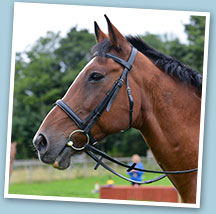
Which bit is right for your horse?
Choosing the correct bit can make an amazing difference to your equine friend’s temperament and performance, according to bitting expert Ema Odlin. With so many available, Ema guides us through the most common bits on the market, and describes how, and why, they work.
Many riders just pick up the first bit they have lying around and expect their horse to work into the contact. But fitting a horse with the correct bit is even more critical than choosing the right saddle as incorrect bits can cause head shaking, bolting, damage to the teeth and even bridle lameness, to name but a few problems. Put simply, the bit is to a horse and rider what golf clubs are to a golfer – the right equipment is crucial.
Different breeds of horse have different mouth conformations, which means they require bits with different types of action and mouthpieces. For example, a horse with fleshy lips is better with a bit that has minimal collapse, ie, less nutcracker action. It is also important to use the right thickness – some riders are tempted to select bits with a thick diameter because they believe them to be more comfortable and therefore kinder, but this is not always the best choice, as some horses do not have the clearance between the upper and lower jaw to physically fit a larger-diameter bit.
If you are unsure of the conformation of your horse’s mouth, it is always worth asking your horse’s dentist.
Snaffles
These are the bits that owners are most familiar with. A snaffle is a cheekpiece that can only create direct pressure on the tongue, the corners of the mouth and the bars (the spaces between the horse’s front and back teeth).
Snaffles can include mouthpieces such as a standard jointed, a lozenge and a french link, as well as more complex, harsher mouthpieces, such as the fast twist. The lozenge double-jointed mouthpiece has been very well received by many breeds, as the lozenge helps to maintain a consistent, well-regulated contact on the tongue. It seems to help the horse to relax into the bit, while the double break prevents the centre section from pushing up on the roof of the mouth.
Loose levers
Loose lever bits (also known as gags) often have the same mouthpieces as snaffles. As the name suggests, they also have a loose ring cheek, which generally has the addition of a further ring at the top, to which the bridle attaches. There are a further one or two rings below, to which the rein can be attached to create extra leverage against the poll (the more sensitive point just behind the ears on the top of the head). Examples of loose lever bits include the Dutch Gag, Universal Gag, Pessoa and 3 Ring French Link Gag.
Curbs
Curb bits can be split into three categories: Pelhams, Weymouths and Kimblewicks.
The Pelham is a single mouthpiece bit with a cheekpiece that includes a shank, allowing the use of two sets of reins. The top rein, known as the snaffle rein, puts pressure on the tongue, the bars and the corners of the horse’s mouth, just like a snaffle. It is attached to the snaffle ring. The second rein, called the curb rein, is used on the ring at the bottom of the shank to apply further pressure on the poll and the curb chain when the rein moves the shank backwards.
The Weymouth, also known as a curb bit, is the second bit of a double bridle set, used predominantly in showing and higher-level dressage. This bit works in the same manner as a Pelham’s bottom rein. However, the snaffle action comes from an additional bit with smaller 55mm rings, called a Bradoon.
Younger riders often use Kimblewicks as they provide some extra control for a less experienced rider – or a horse that is a little too strong for a snaffle. There are two main types of Kimblewick. The first version, called an Uxeter Kimblewick, has two rein slots in the cheekpiece. The second version has a plain cheek, where reins are attached in the same way as a snaffle. Both types are used with a curb chain, which adds pressure into the curb groove. The Kimblewick is designed to use four points of pressure: the tongue, the corners of the mouth, the bars and the curb groove, and in some later versions, a small degree of poll pressure too.
Ask an expert
Methods of bitting horses have changed over the years as we’ve begun to understand more about their needs. Because of this, it’s a good idea to ask advice from a bitting expert rather than to rely on the knowledge of your trainer or stable pal. ‘Bit banks’ can be helpful too – these are places that allow you to borrow and try out bits so you can find the right one for your horse. You might like to try thehorsebitshop.com.



